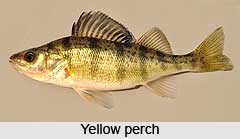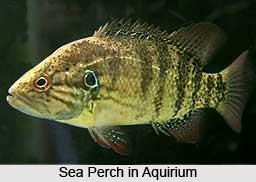 Sea Perches constitute a varied group of marine creatures both large and small, covering several families living in seas of the entire sub-continent and even abroad. Only a few of these are, however, described are in Indian seas. The dominant group is the serranidae or the groupers, also called `rock cod` although having no relationship with the real cod. They are robust-bodied, with a large mouth beset with teeth, smaller behind and canine-like in front. Considerable confusion prevails about the scientific names of many sea perches.
Sea Perches constitute a varied group of marine creatures both large and small, covering several families living in seas of the entire sub-continent and even abroad. Only a few of these are, however, described are in Indian seas. The dominant group is the serranidae or the groupers, also called `rock cod` although having no relationship with the real cod. They are robust-bodied, with a large mouth beset with teeth, smaller behind and canine-like in front. Considerable confusion prevails about the scientific names of many sea perches.
Ephinephalus lanceolatus, E.maculatus and E.tauvina (Serranidae) are some of the large perches growing from two to four metres and are very long-lived. The first one is very attractive, black-and-yellow coloured when young, and after sixty centimetres in length becoming dark black with yellow spots, a kind of spectacled perch, though this name is given to the third species, which is pale chocolate coloured with black nondescript spots. Living amidst submerged rocks and caves and being carnivorous they feed voraciously on small fish which also normally take shelter in the same habitat. Prawns and lobsters also appear to be favoured food as perch have been seen to devour such material avidly even in the enclosed space of an aquarium.
Snappers (Lutjanidae) derive their name from their habit of snapping their prey, a habit that facilitates their capture by anglers on baited hooks. They are marked by a roundish dorsal profile, prominent eyes and a mouth with slightly shorter lower jaw. The abdominal line (ventral profile) is somewhat straight. Being carnivorous they always go after smaller fish. Some of them are copper-coloured and so are called tambusa or tamb in Mumbai (Bombay). One of them, Lutianus johnii, has a pale golden sheen all over, the upper half of the body being speckled with rich brown spots; large specimens measure eighty centimetres and weigh eight kilograms. L. annularis is brilliant red but smaller in size (about sixty five centimetres). L. roseus is cherry red in appearance and is caught in shoals, the catch making a dazzling red heap on the boat deck. The young of L. argentimaculatus enter estuaries and take shelter among loose stones of the marginal bunds in wait for their prey (small unwary fish). If any fisherman incautiously puts his hand on the stones the fish bites his finger, and hence the local name chavri tamb meaning `biting snapper`.
 Cardinal fish belonging to the family Apogonidae are small perches found in coastal weeds, rock pools and coral reefs. Unlike other percoids, their dorsal fin is divided into two small fins. In Ambessidae, where except three freshwater forms the rest are marine, the dorsal fin was nearly divided; but in this family the division is complete. Being variously coloured to match the surrounding in their natural habitat, Cardinal fishes, being usually small, (less than ten centimetres), are attractive aquarium fishes, taking copepods, Mysis crabs and other artificial feed.
Cardinal fish belonging to the family Apogonidae are small perches found in coastal weeds, rock pools and coral reefs. Unlike other percoids, their dorsal fin is divided into two small fins. In Ambessidae, where except three freshwater forms the rest are marine, the dorsal fin was nearly divided; but in this family the division is complete. Being variously coloured to match the surrounding in their natural habitat, Cardinal fishes, being usually small, (less than ten centimetres), are attractive aquarium fishes, taking copepods, Mysis crabs and other artificial feed.
Sciaenids (Sciaenidae), commonly known as Croakers because of the peculiar sound they make with the help of their air-bladder, and also called `jew fishes`, occur on both coasts of the Indian sub-continent including Sri Lanka. There are twenty species. The dorsal fin is incompletely divided into a spinous part in front and a soft part behind; their nose is blunt and eyes prominent. Being largely demersal (bottom-dwelling) in nature, they subsist on prawns, crabs, squids and other fishes found at the bottom. Most of them inhabit coastal waters of about forty fathoms depth but some species enter estuaries and backwaters for feeding. Otolithoides brunneus, Protonibea diacanthus and Wak sina are some of the large sciaenids of this group. The first is more elongated in body form, with a long dorsal fin, and is reported to grow to two metres and weighs forty five kilograms. The same measurements are reported for Wak sina though P. diacanthus is known to grow only up to 1.4 metres and 16 kg. Most of the other species do not grow beyond thirty centimetres and are referred to as Small Sciaenids or Dhoma. They occur almost throughout the year and spawn in April and May. Dhoma constitute a large part of trawler catch on the northwest coast of India. Because of their habit of making grunting sounds, fishermen listen to such sounds in quiet backwaters and dive to the bottom to catch them by hand or in small nets. The air-bladders of these fishes are dried and used for making isinglass which is used in confectionery and for jellies.
The family Carangidae, which includes the Horse Mackerels, has several genera and species of varied types. Generally the fish are oblong, elevated, and flattened side to side. The central scales, especially in the tail region, are thickened, forming a hard keel. Most of them are fast swimmers inhabiting surface waters and having a tendency to school together to hunt other small fish for food. Many do not grow beyond 40 cm but some (e.g. Megalaspis cordyla and Scombroides tala) grow up to 1.5 m. The last-named is also called Porthole fish because the circular blotches on its body resemble the portholes of a ship. Most of the smaller varieties of the genera Selar, Citule and Caranx are known as Horse Mackerel though they have no relationship with the true mackerel. Three species of Trachynotus look very similar to true pomfret but being different taxonomically are called pseudo-pomfrets or pompano. As a group, the horse mackerels are not very popular as food but when cured with salt they are acceptable.
Drepane punctata, the Spotted Dory of the family of Drepanidae, is a beautiful silver fish with head and body elevated and compresses side to side, and with black spots in parallel rows vertically disposed. Though not much valued as food, adults over 40 cm are outstanding because of their silvery colour and rounded shape. Sea-Bream (Sparidae), Acanthopagrus berda, is another perch of rocky environment which is popular as food, though not much is known about its life-history. Pomadasyidae is a heterogeneous family which contains the common food fish Pomadasys maculates and also colourful aquarium varieties. These latter two varieties, known as Squirrelfish, usually hide in coastal weeds and pour on small prawns and copepods which come their way.
Another interesting family of perch-like fishes is Chaetodontidae which includes the variously colourful Butterfly-fishes. They are usually short, deep-bodied, flattened side to side and with a small round tail. Being habitants of rocky coastal areas and coral reefs around southern India and Sri Lanka, the variegated lines and colour patterns on their bodies effectively help them as camouflage in their environment. The banner-fish, with one or two dorsal fin-rays elegantly elevated banner like, and with black and yellow stripes on the body, looks attractive. The Blue Ring Pomocanthus annularis has undulating blue stripes, as its name suggests. Its young ones are so differently coloured - dark blue body with white concentric rings - that for some time they were considered to be of a different species. They are also referred to as Blue-Ring Angel-fish. The Emperor fish, Pomocanthus imperawr, with its opercular spine, wavy yello lines on a blue-golden body and a golden tail, is so outstanding and majestic that it deserves its name. Some of these fishes in their young larval stages are quite different in shape and colour and have bony shields on their head and spike-like structures jutting out from the opercular bones to protect them from their larger cousins. Chaetodonts, as a group, are some of the prettiest varieties of aquarium fishes from the tropical world and assume different names.



















